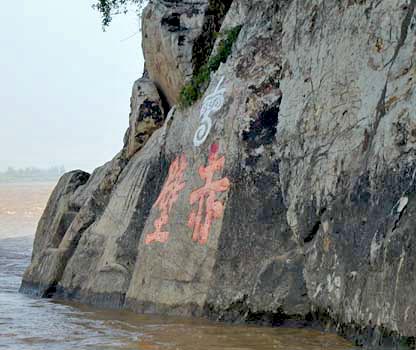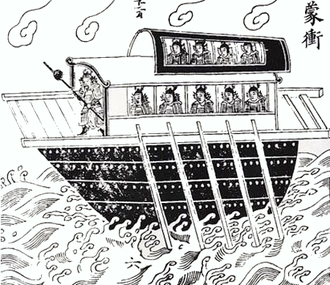I Ching, Yijing or Zhou Yi
"Oracle of the moon": © 2000 LiSe
 Yi Jing, Oracle of the Moon
Yi Jing, Oracle of the Moon


Waiting for the East wind

Engravings on a cliff-side mark one widely accepted site
of The Battle of Red Cliffs,
near present-day Chibi City in Hubei.
The engravings are at least a thousand years old.
Verse 55
Drizzling rain, heavy clouds, dampness
The riverside path is obstructed
Roads and informations are far away
The battle relied on the east wind
The Battle of Red Cliffs
Zhuge Liang (the alleged writer of the Shenshu) was Liu Bei's main advisor. He negotiated forming a mutual front with Sun Quan against Cao Cao. Divisional commander Huang Gai was the one who used the east wind to send his fire-ships in the right direction.

Jangtze river
Liu Bei and Sun Quan successfully frustrated Cao Cao's effort to conquer the land south of the Yangtze River and reunite the territory of the Eastern Han dynasty.

One type of ship used in the battle, the Mengchong. A leather-covered assault warship designed to break enemy lines.
Divisional commander Huang Gai sent Cao Cao a letter feigning surrender and prepared a squadron of capital ships. The ships had been converted into fire ships by filling them with bundles of kindling, dry reeds, and fatty oil.
"The battle relied on the east wind"
As Huang Gai's "defecting" squadron approached the midpoint of the river, the sailors applied fire to the ships before taking to small boats. The unmanned fire ships, carried by the southeastern wind, sped towards Cao Cao's fleet and set it ablaze.
Following the initial shock, Zhou Yu and the allies led a lightly armed force to capitalise on the assault. The northern army was thrown into confusion and was utterly defeated. Seeing the situation was hopeless, Cao Cao then issued a general order of retreat and destroyed a number of his remaining ships before withdrawing
The riverside path is obstructed
Roads and informations are far away"
Cao Cao's army attempted a retreat along Huarong Road, including a long stretch passing through marshlands north of Dongting Lake. Heavy rains had made the road so treacherous that many of the sick soldiers had to carry bundles of grass on their backs and use them to fill the road to allow the horsemen to cross. Many of these soldiers drowned in the mud or were trampled to death in the effort.
The allied counterattack might have vanquished Cao Cao and his forces entirely. However, the crossing of the Yangtze River dissolved into chaos as the allied armies converged on the riverbank and fought over the limited number of ferries. To restore order, a detachment led by Sun Quan's general Gan Ning established a bridgehead in Yiling to the north, and only a staunch rearguard action by Cao Ren prevented further catastrophe.

The fu dates from 1082.
(All information from Wikipedia

The Battle of Red Cliffs is the origin of a proverb:
万事俱备,只欠东风
'all ready, only lack east wind'.
This means that everything is ready except what is crucial.
From the "Romance of the Three Kingdoms" (《三国演义》), t